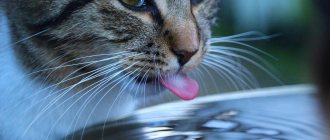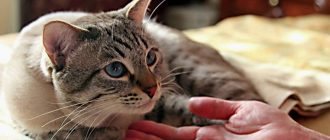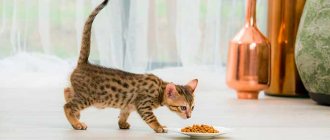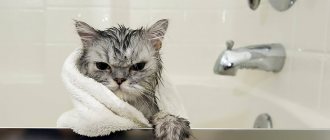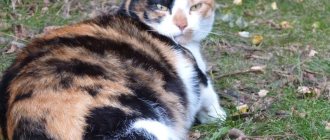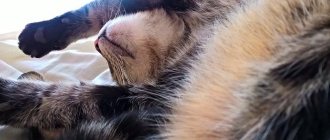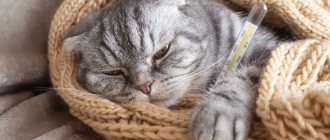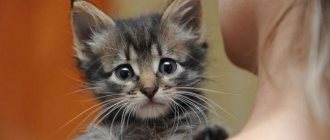A cat is a predatory animal and this causes many physiological characteristics of its body and diet. Felines, like all predators, have a special structure of teeth and jaws - fangs are designed to tear prey; they do not have root chewers, like omnivores.
Their stomach is single-chamber and is not intended for large amounts of food. The vomiting center of the brain is well developed, since females in the wild often feed their young with regurgitated masses. Felines are not scavengers; the prey they eat is always warm, which is why pets prefer non-cold food. Because of this, they have a reputation for being picky and fussy eaters. But the cat’s rejection of food, especially if it also refuses water, should alert the owner.
Reasons for refusing to eat
The cat is selective about food, sometimes even refusing its favorite treat. But refusal does not always indicate pathologies. A cat or cat may not eat for more than a day if:
- ate too much the day before;
- walk outside and eat somewhere else;
- they developed temporary digestive problems due to increased physical activity;
- they were switched to a new, unusual diet;
- the female has a week left until her heat or she is just coming;
- in the male, the rutting period is underway, he feels a female nearby;
- offended by the punishment, the owner’s inattention;
- they are given dirty dishes, spoiled food;
- The female has just given birth; on the first day (sometimes two) after they do not eat, as they have eaten a large amount of placenta.
But if a cat goes hungry for more than a day, this is already a cause for concern.
Pathological factors of food refusal:
Stress
It can be a consequence of the loss of the owner, melancholy, loneliness, fear, or other unfavorable reasons. Moving to a new apartment or house, the appearance of other pets, illness or injury always affects the psychological state of cats and provokes a refusal to eat for several days. It is not always possible to cope with this on your own; you should seek specialized help. Taking sedatives will help restore your appetite.
Also read the article on how to calm your cat.
High ambient temperature
This adversely affects the cat's appetite; heat stroke is very dangerous, since these animals do not have sweat glands. Long-haired breeds or pets with short but dense hair suffer especially from the heat. If the cat is no longer young, suffers from heart or other chronic diseases, this factor is aggravated.
Parasitic infestation
Worms, fleas, other external parasites. The cat develops vomiting and diarrhea, and its stomach becomes swollen.
If severe intoxication of the body occurs, there is a risk of rupture of the stomach, intestines and liver. In this case, deworming should be carried out under the supervision of a veterinarian.
Hairballs
They are formed as a result of licking and cause obstruction of the food tract. This problem occurs especially often in long-haired breeds. To push through the lump, there are special medications in the form of pastes.
Viral and bacterial infections
Coronavirus, rhinotracheitis, calcivirus, panleukopenia first cause a deterioration in the general condition of the animal, then primary symptoms appear in the form of sneezing, coughing, salivation and lacrimation. Refusal of food and water, dehydration usually accompany these severe pathologies. Treatment should be started immediately upon initial symptoms.
Diseases caused by pathogenic bacteria are most often secondary complications of viral infections and are accompanied by poor appetite. Treatment at a veterinary clinic is required.
Anorexia
It occurs as a result of stomatitis, dental lesions of the oral cavity, long-term use of antibiotics, and anticancer therapy. Most often it is caused by dental problems - congenital partial teeth, tartar formation, caries, and malocclusion.
Also read the article about why your cat has lost weight and what to do about it.
Systemic diseases
Bronchitis, pneumonia, pathologies of the heart, liver, and kidneys worsen the general condition of the animal, causing lethargy, apathy, and poor appetite. Specialized therapy is required.
Malignant neoplasms
Even more severe damage to the body. Anticancer therapy and sometimes surgery are required.
Urolithiasis
It is especially common cause of refusal to eat in neutered cats. Often leads to blockage of the urethra and intoxication of the body. A proper diet and constant monitoring in the clinic are important.
Poisoning
Household chemicals, rat poison, medications. The vomiting center in the cat’s brain, which is well developed due to natural features, easily provokes vomiting. This protective reaction often saves the animal’s life when dangerous substances enter the body. But from rat poison, in which the concentration of insecticides is extremely high, the cat easily dies. Every effort should be made to protect your pet from rodents. Deratization should be carried out only in the absence of pets.
Pain
Pain from injuries and wounds most often causes loss of appetite. It is necessary to alleviate the animal’s condition with the use of pain medications.
Foreign body in the food tract or stomach
This condition can lead to injuries to the gastrointestinal tract, rupture of the esophagus and stomach. Often accompanied by inflammatory processes with vomiting and diarrhea. Surgery is usually required.
Something got into the stomach or intestines
What to do if your domestic cat does not eat at all due to a foreign body entering the stomach:
- do not try to feed your pet (severe vomiting may occur);
- do not do an enema yourself (there is a risk of serious damage to the intestines);
- do not give your cat antiemetics or laxatives, as they will not solve the problem and will only worsen the general condition;
- Seek help from a qualified veterinarian as soon as possible!
Any foreign body can enter the animal's body, including indigestible sausage skins, scraps of wool and bones. This is a very dangerous condition for the animal, known as intestinal obstruction. If timely medical care is not provided, there is a high risk of death.
The death of a pet occurs due to the release of gastric juice and its stagnation in the intestines. An unfavorable process is accompanied by vomiting, the abdomen becomes enlarged, and when pressure is applied the cat experiences severe pain. Do not try to solve the problem yourself; any wrong action can lead to irreversible consequences.
In such a situation, only an experienced veterinarian can help your four-legged friend and determine the exact cause of the lack of appetite. In some cases, emergency surgery is required to save the life of a furry family member.
The reason is character
All cats are picky eaters, but in some cats, due to their nature, food whims are more pronounced. A cat “with character” may not eat for more than a day due to new, unusual or tasteless food, resentment towards the owner, or a change of environment (moving to a dacha, to a new apartment). This behavior is typical for some breeds - British, Scottish fold, Sphynx.
Sooner or later, the cat will come to terms with changes in diet or environment and will begin to eat normally. It is only important that she does not stop drinking water. If a short fast does not cause significant harm to the pet’s body, then dehydration is very dangerous.
When force feeding is contraindicated
Animal instincts tell them a rational line of behavior, so a sick animal loses its appetite.
Old-school veterinarians do not recommend force-feeding cats, arguing that a sick body is not able to digest food, and an unbalanced metabolism will perceive food not as help, but as poison.
However, there are conditions where force feeding will actually do more harm than good. These are:
- Poisoning . In this case, actions are taken aimed at increasing the removal of the toxic substance from the body (artificially inducing vomiting, giving a cleansing enema, giving a laxative, intravenous infusions) and slowing down its absorption into the blood.
- Shock after injury . Pain and severe stress contribute to a sharp shift in metabolism and inappropriate behavior. As first aid, urgent measures are required to stop bleeding, fix the injured part of the body, as well as administer sedatives and cardiac drugs.
- Condition after anesthesia and surgery . Disorientation in space, dullness of sensitivity and disruption of muscle function lead to the loss of habitual behavioral reactions. Depending on the specifics of the surgical intervention, fasting is prescribed for 24-78 hours, and only after complete recovery from anesthesia and stabilization of the condition, dietary feeding with a gradual expansion of the diet is indicated.
- Acute gastrointestinal infection of a bacterial or viral nature . In this case, it is necessary to take emergency measures to relieve vomiting, diarrhea and general intoxication by introducing antibiotics, immunostimulants, sorbents, antispasmodics and detoxification drugs into the body.
- Attack of acute pancreatitis. For 2-3 days, the sick animal is shown fasting with intravenous administration of medicinal solutions, and only subsequently – fractional feeding in small portions.
Dehydration is much more dangerous than starvation, so drinking enough fluid or (in severe cases) intravenous infusion of special solutions that restore water-salt balance is a priority in all pathological conditions.
How long can a cat normally go without eating?
- healthy adult - up to five days;
- up to six months - no more than a day;
- elderly cat - up to three days;
- cat after birth - one or two days;
- after surgery (anesthesia) - up to two days;
- pregnant woman - up to two days;
- animal with chronic diseases - no more than two days.
If the hunger strike continues longer, you should make every effort to feed the animal, offering it warm food and a favorite treat. Or contact a veterinary clinic for specialist help.
In what ways can you stimulate an animal's appetite?
Cats may refuse to eat in the spring, during the grooming period, and also after castration. In such cases, no special help is required; after a few days, the pet’s condition will stabilize, and he will again begin to absorb his favorite foods with the same zeal and good appetite.
Pregnancy and previous sterilization can affect a cat's appetite. In this case, you need to do the following:
- The cat does not eat in the early stages of pregnancy and before giving birth. During this period, temporary vomiting, drowsiness and increased salivation may also occur. If more critical signs are detected, it is better to consult a doctor, since serious ailments combined with loss of appetite can already clearly indicate painful processes in the body of a pregnant cat.
- Hunger strike is also often observed in the postpartum period, for which there are several good reasons. As a rule, they are not critical and do not pose a threat to her life. In just a few days, the new mother will recover from stress, recover morally and will definitely show an inexorable desire to eat deliciously.
- After sterilization, the cat recovers from anesthesia for a long time, so you should not expect an eagerness to consume food. Over the next few days, the hunger strike may continue, which is associated with the stress experienced and hormonal changes. If you don't have an appetite within a week, consult your doctor. Perhaps she will be prescribed vitamins or other complexes for quick recovery after sterilization.
And yet, you should not force your pet to eat. Look for the cause, take adequate measures and do not ignore serious signs of illness. The health and life of your pet is in your hands!
Why doesn't the kitten eat?
There are many factors that influence the appetite of a small kitten. The main ones:
Stressful state
When a baby comes to a new home from a nursery, he is always torn away from his mother, his nest. He lacks the usual affection and attention, often he does not know how to take care of himself. Sometimes the move is accompanied by a complete refusal to eat and drink; the kitten may not go to the toilet even once for two days.
This condition is very dangerous, since against the background of stress, rapid dehydration and intoxication of a young body with insufficient immune defense occurs. During this period, it is important to show increased attention to the pet, surround it with love and protection, pick it up more often, and play. Offer a treat with an appetizing smell and create a comfortable environment.
New food regime
In the nursery, the baby, even receiving additional nutrition in the form of specialized formulas, still suckled on his mother. The loss of mother's milk in the diet is a shock for the kitten, both in terms of the nutritional component and psychologically.
Early weaning
Is food stress. The kitten simply does not know how to eat other food. In this case, it must be fed with cat milk substitutes, which are sold in veterinary pharmacies, or with goat milk.
Dishes
The baby refuses food because of an unusual bowl that is too bright or a plastic plate with a strong smell.
Spoiled food
Spoiled food particles also cause poor appetite.
Worm infestation and parasites
In a kitten, it is often a factor in poor appetite or complete aversion to food. The baby is losing weight, the condition of the coat is deteriorating, drooling, vomiting, and diarrhea appear. Deworming is necessary or, if the animal’s condition is of concern, observation by a veterinarian. External parasites can provoke similar factors.
Virus or other infection
The kitten refuses to eat due to inflammatory diseases of an infectious nature. The baby should be saved immediately; the pet can quickly die.
In what ways can you stimulate an animal's appetite?
An animal on a natural diet should be offered a choice of several approved products. Perhaps he is tired of meat, but kefir, fish, and fresh cucumber will awaken interest in food.
The same taste of dry food and its texture discourage the desire to eat. Replacing a dry diet with wet spiders or pate can solve the problem of lack of appetite. A temporary switch to “crackers” from another manufacturer that are of equal quality and have a different taste than what the pet has been receiving lately helps a lot.
Long-term abstinence from food depletes the body, making it vulnerable to bacteria and viral infections. In pregnant cats, fasting for more than a day compromises fetal development.
In some cases, prolonged refusal to eat provokes:
- convulsions,
- glycemic coma
- loss of body weight to a dystrophic state,
- exacerbation of chronic diseases,
- disorders of the kidneys and liver.
You should not use fasting in order to force your pet to eat food that is unpleasant to him. You can often hear similar recommendations when transferring an animal from natural food to “drying” or vice versa: “He will fast for two or three days and start eating.”
The method really works with some animals, while others would prefer to die rather than submit. There is no need to forcefully “unload” your pet; his body knows when to take a break.
If you want to “lose weight,” your cat should reduce the amount of food he eats, add physical activity, but do not starve him, this will disrupt metabolic processes and cause hormonal imbalances. If your pet goes on strike, what do you do in this case?
If a beloved domestic cat suddenly stops eating well or refuses to eat at all, this immediately alerts the owners. The reasons that a pet does not eat food can be different. The most common reason is that the cat is overfed and his body requires unloading. This is the most harmless reason, which usually does not bring with it any bad consequences.
A caring owner will immediately discover that something is wrong with the cat if he has not touched food for a whole day. When a cat does not eat for more than two days, this is an indicator of a serious illness that needs to be treated. The most unpleasant thing is when a pet refuses food and water completely. He may lose serious weight and become very weak. This cannot simply be left alone, which is why veterinary practice often resorts to force-feeding animals.
Assisting an animal when it refuses to eat
To take action, you must first understand the reasons for refusing to eat.
- If the cat does not eat the dry formula, but at the same time happily absorbs the treat, there is no reason to worry. You need to choose a constant food that your pet will eat with pleasure.
- You should carefully observe the behavior of the cat - maybe she is hunting on the street and eating her prey, or someone is feeding her. It may be necessary to limit the cat’s free movement for some time to normalize the feeding regime and diet.
- It is necessary to give the usual food in a heated form, this will certainly cause an increase in appetite in a healthy animal.
- You can try adding special dietary supplements or herbs to your diet that increase your appetite.
- If the reason for refusing food was a hormonal surge, then the situation will normalize within a week at most.
- Try to carefully drink and feed your pet liquid food through a syringe without a needle. If the animal categorically refuses to eat, there is no need to force it, you should consult a veterinarian.
When additional unfavorable factors are added to poor appetite - the cat becomes lethargic, apathetic, vomiting, diarrhea, bad breath - you cannot postpone a visit to the doctor. Most likely, this condition was caused by poisoning, infection or other pathological factors.
Oral diseases in cats
A domestic cat may not eat well if it has dental problems. This cause of loss of appetite is very common. A clear sign of pathology: the animal may drink a lot of liquid, choke on food, burp after eating solid food, etc. Loss of appetite occurs due to a lack of teeth in a row, which provokes the development of certain diseases of the gastrointestinal tract.
The source of such problems can also be dental caries, gum disease, tartar accumulation and other dental ailments typical of humans. To prevent such conditions and not to risk the health of a purebred cat, carry out hygienic care of its oral cavity in a timely manner. If you detect obvious signs of an inflammatory process, consult a doctor.
If dental disease has already caused loss of appetite in your beloved cat, try to choose the optimal set of foods for feeding. Eliminate solid foods, grind all food served, and be sure to consult your veterinarian. Your friend may need medication help.
Poor appetite in a domestic cat may indicate the development of pathological processes in the liver, kidneys and urolithiasis, which often occurs due to poor quality nutrition. According to statistics, such diseases are diagnosed in felines three times more often than in dogs.
You can determine exactly what the problem is by the following symptoms:
- the cat behaves lethargically, the condition noticeably worsens;
- can drink large amounts of water at one time;
- there is an unpleasant odor from the mouth;
- frequent urge to urinate;
- there are blood impurities in the urine;
- vomit;
- convulsive conditions;
- elevated temperature;
- weight decreases;
- if you stick out your tongue, you will notice an uncharacteristic yellow coating;
- increased salivation;
- anemia and signs of dehydration.
We suggest you familiarize yourself with: Scotch Terrier or Scottish Terrier
With such symptoms, the animal must be urgently shown to a specialist!
Risk group: cats over 7 years old.
Forecasts for the animal:
- Kidney diseases can be treated if promptly consulted by a veterinarian;
- if the disease is advanced, there is a possibility of becoming chronic, which will require regular support for the cat’s health to prolong and improve the quality of its life;
- With liver diseases, obesity is observed, which also negatively affects the general condition of the pet and shortens its lifespan.
Even if your cat is sick, do not rush to part with your furry friend. Provide her with the necessary help, provide care and love, because any disease can be treated, especially if you are next to her during this difficult period!
When is it necessary to go to the doctor?
Be sure to consult a veterinarian if your pet has poor appetite if additional adverse symptoms are present:
- repeated vomiting;
- loose frequent stools, especially with blood;
- decreased general tone, apathy;
- complete refusal of water;
- ineffective intermittent urge to urinate or defecate;
- pain in the abdominal cavity;
- bloated belly;
- sneezing, drooling, discharge from the eyes;
- formation of dry, painful crusts on the nose and around the mouth;
- feverish condition.
First aid for a cat if it stops eating
First of all, you need to identify the cause of loss of appetite. Analyze the changes over the past few days, observe the pet’s condition. If additional symptoms are observed that clearly indicate that your cat may be sick, contact your veterinarian as soon as possible and follow all instructions from an experienced veterinarian.
Thus, you will be able to not only restore your furry friend’s appetite, but also relieve him of the painful symptoms that often accompany any pathological processes in the body.
If your domestic cat shows no signs of illness, try changing the diet. Add your animal's favorite foods to the menu and replace food. Do not let him outside for a while, carefully monitor all changes that occur. If your cat comes up to the bowl throughout the day, sniffs the food, and leaves without touching the food, the cause of the hunger strike may be typical overeating.
If there is nothing unusual in the cat’s behavior, the owner should not take emergency measures. Most likely, the cat decided to relieve the gastrointestinal tract, obeying natural instincts. It is necessary to provide him with access to a sufficient amount of clean drinking water and periodically offer him food. He will decide for himself when it is time to return to his usual diet.
Be sure to read:
The cat eats poorly and constantly sleeps, is lethargic: normal or pathological, the reason, what to do when you need help
If the cat looks depressed, his whole appearance indicates malaise, there is vomiting, diarrhea, the temperature has risen above normal, or the hunger strike lasts for 3 days or more, it is necessary to pay a visit to the clinic to eliminate the possibility of a serious illness or begin treatment as early as possible.
We invite you to familiarize yourself with: Welsh Terrier – photo, breed characteristics, puppy price
Prevention
To prevent your pet from refusing to eat, the following simple measures should be followed:
- normalize diet;
- do not allow the cat to be outside uncontrolled;
- diversify your diet;
- feed the animal only premium and super-premium mixtures;
- exclude food from the human table;
- choose food in accordance with the cat’s taste preferences;
- avoid stressing the animal;
- sterilize your pet in time or provide him with a full sex life;
- carefully transfer to a new diet, especially kittens;
- prevent the animal from overheating in the hot season;
- vaccinate annually;
- regularly deworm and treat for external parasites;
- Long-haired breeds should be combed out and given pastes to prevent the formation of hairballs;
- Bring your pet to the veterinarian regularly for checkups.
What to feed
Nowadays there is a large amount of animal food on the market, but even with this, owners are faced with the question of how and what to feed a cat if it does not eat anything. It is recommended to give preference to ready-made foods that are specifically designed for use in the treatment of a specific disease.
How to find a cat if it has run away or is lost on the street
Most often, this is liquid food that can be fed to the animal from a syringe, or the cat itself can lap it up like water. This food is tastier than usual to attract the sick. In this case, the cat is more likely to prefer something liquid than solid food. In addition, this food is high in calories, so as not to force your pet to eat more often than necessary.
Note! Such food should not be considered a panacea and should not be grabbed from the shelves if the animal refuses food. You need to consult a veterinarian who can tell you what to feed your cat if he doesn’t eat anything.
Proper nutrition
A speedy recovery for a pet after intoxication is impossible without following a proper diet. What to feed a cat after poisoning is a concern for every responsible owner. As a rule, after an illness the animal loses its appetite for a long time.
However, special attention should be paid to nutrition issues
Due to the fact that many toxic substances are highly soluble in fats, at first you should not give the animal food containing them. Only vegetable fats are allowed in small quantities. This issue is especially relevant when phosphorus-containing substances (usually pesticides) and rat poison enter the body. For the same reason, you should not feed your animal milk. In addition, fatty foods will slow down the recovery of the liver, which suffers from any poisoning of the body.
Therapeutic food for a cat after poisoning should be gentle on the digestive system. Experienced breeders recommend feeding your pet during the recovery period 3 - 4 times a day for 1.5 - 2 months after poisoning.
Congee
If intoxication has occurred due to eating poor quality food, then after a daily fasting diet the animal should be given rice water. It is prepared in water.
After 2 - 3 days, the pet can be offered viscous porridge based on rolled oats and pureed buckwheat. You should not feed a sick cat pearl barley, semolina, or corn porridge.
Gradually, you can add boiled vegetables (carrots, broccoli, pumpkin) to your diet. After 5-7 days, if the pet’s condition is satisfactory, lean poultry and rabbit meat can be introduced into the diet. The meat should be given boiled, in small pieces or crushed in a blender until pureed. Fatty fish, table food, and canned food are strictly contraindicated.
You can give your animal low-fat cottage cheese. You should abstain from milk, cheese, and sour cream for the first 2 to 3 days. It is useful to give low-fat kefir if there is no digestive upset.
If before poisoning the animal was fed with ready-made formulas, during the recovery period it is recommended to give super-premium medicinal food, for example, Hills I/D for food poisoning, Hills L/D for liver problems due to toxic substances or K/D, if the kidneys were damaged by poisoning.
In the Royal Canin food line, you can use the Gastro Intestinal composition, which ensures maximum digestive safety, as well as Hepatic food, which supports liver regeneration. A veterinarian will help you choose one or another medicinal food, taking into account the type and form of poisoning.
Cat food recommended for consumption after poisoning
Owners often note that after poisoning the cat does not eat. After severe intoxication, this phenomenon is often observed. If there is no appetite for 2-3 days, you should not force feed the animal, as this may provoke vomiting. If the general condition of the sick pet is weakened, it should be regularly taken to the veterinary clinic for the administration of intravenous nutrient solutions. For this purpose, infusions of 40% glucose solution and saline are used.
Features of syringe feeding
Before starting feeding, you should consult your doctor about the size of the syringe. You can ask him to give the desired option so as not to make a mistake. Most often its size is 2 ml.
You need to cut off the tip of the syringe, pull the plunger out of it, and fill it with food. After this, you need to bring the tool to the cat’s nose so that the pet can smell the food. When the pet opens its mouth, lightly press the plunger, squeezing a small amount of food onto the tongue. If the animal does not open its mouth, then you need to do it yourself, since you need to force the cat to eat.
How to feed a sick cat with a syringe
Homemade food for kittens and adult animals
When buying a kitten from a breeder, almost everyone is interested in the baby’s usual diet. The grown-up animal can already cope quite well without mother’s milk and is accustomed to eating from a common bowl. In the first days, try not to disrupt the baby’s usual diet, because moving to a new unfamiliar place will be a big shock for him. But when the cat is completely comfortable, you can switch him to homemade food.
The transition to new food should be done gradually. First, add a little homemade food to the usual food, and then completely replace the entire feeding. Young kittens usually respond painlessly to changes in diet, which cannot be said about adult pets.
When switching from dry food to healthy food, an older cat may demonstratively turn away from the bowl and organize a “boycott”. This does not mean at all that in the future the pet will not eat anything except industrial food. The fact is that he simply experiences a “dependence” on dry food.
Dry food contains large quantities of monosodium glutamate, which not only gives the product an unnatural, sharp taste, but also irritates the taste buds. That is why a cat, accustomed to rich aromas and tastes, does not want to eat natural products that are not endowed with such qualities. The animal will most likely resist the introduction of a new diet, meow and ask for its favorite “snacks”; it is quite possible that it will refuse food and thereby attract pity. Getting your cat to eat healthy food will not be easy, so you should be patient and stick to your plan. Moreover, natural products introduced into a cat’s diet will only bring benefits to the pet.
Healthy Pet Diet
Before you start feeding your cat homemade food, you should familiarize yourself with information about products that can and should be included in your pet’s diet.
- Meat base. Meat is best given to animals raw. To avoid the appearance of worms, you should first freeze raw, lean meat pieces and feed your cat after they have been completely thawed. Young kittens can scald raw meat with boiling water before feeding. The best foods to feed are chicken, beef, turkey, and horse meat. It is better not to give lamb and pork to cats.
- Fish. Inhabitants of rivers and seas must be included in a cat’s diet only after heat treatment. Fish can be fed to cats no more than three times a week.
- Vegetable component. The cat's diet must be filled with vegetables. It is best to include boiled carrots and pumpkin in your food. Boiled and baked onions will also enrich your furry pet’s diet and replenish potassium deficiency. But you should avoid potatoes because of the starch they contain and the high glycemic index.
- Cereals. It is preferable to use oats and pearl barley for feeding cats. Many cats do not eat buckwheat porridge, but semolina itself is not recommended by veterinarians (it contains a lot of carbohydrates, which can cause obesity).
- Milk and dairy products. Fermented milk products with minimal fat content are healthy and are indicated for inclusion in the diet of cats. Any cat will eat natural yoghurts, bifidokefir, and low-fat cottage cheese with pleasure. But you should avoid sour cream, cream and milk. These foods can cause both intestinal upset and constipation.
When preparing food for feeding cats, you do not need to add spices and salt. Animals should not interrupt the natural taste of food with various seasonings.
Rules for switching to new food
When changing your usual diet, you need to be patient and consistent. You should not scold an animal or indulge it when it presses for pity. A sharp transition is harmful to health, so the new food needs to be mixed a little with the old one. On average, this takes 1-2 weeks.
Frequent product changes are harmful!
Frequently changing brands is fraught with problems with the gastrointestinal tract. To avoid diarrhea and constipation, veterinarians recommend sticking to a specific brand even on a therapeutic diet. This is not so difficult, since most manufacturers produce several lines that take into account the age and other characteristics of the animal.
Transition from straight
It's not safe to mix different types of foods, so don't be surprised by temporary bowel problems. In this case, this cannot be avoided, so be patient and adhere to the following scheme:
- 25% “drying” and 75% natural – 1-4 days;
- 50% of each type – 5-9 days;
- 75% “drying” and 25% natural – 9-14 days.
At the end of 2 weeks, pellets should make up 100% of the diet. For the first 4 days, you can soak them a little in water so that your pet is not scared off by the unusual consistency.
Switching from wet food
Feeding only wet canned food softens the gums, causing increased bleeding and premature tooth loss. For this reason, they should be combined with dry granules.
The principle of transition here is similar to the previous point. The only difference is that the final proportion must correspond to the instructions on the food packaging. There are detailed rules for feeding animals with 2 types of food.
Please note that increasing the amount of dry kibble will require a large amount of liquid to digest it. Make sure your pet drinks enough water and replace it with fresh water regularly.
Switching from one brand of granules to another
“Crusks” of different brands differ in taste, smell, shape and consistency. Because of this, animals have many reasons to ignore a new type of food.
If your pet selectively eats the granules that are familiar to him, try lubricating the new food with spider jelly. The taste and smell of meat pieces are more intense, so the cat will eat food unfamiliar to him with great pleasure.
Mix in the new food gradually and monitor the reaction. If your pet does not have health problems, do not add a new portion until he eats what is left in the bowl. Thanks to hunger, the cat will eventually come to terms with the new diet and will not be picky.
Conclusion
If your cat doesn’t want to eat dry food, don’t scold her and try to figure out the reason for her refusal. In most cases, the problem that arises is associated with errors made in care and maintenance. All of them can be fixed and are not critical, so do not rush to attribute the problem to pickiness ahead of time.
The article is for informational purposes only. Contact your veterinarian!
Natural products for cat exhaustion
The products from our table are not suitable for dietary therapy of cats with cachexia (moreover, such food is not suitable even for healthy animals). Our food may contain sugar, salt, spices, smoked meats, and dyes that are contraindicated for cats.
The cat must drink water. If she refuses to drink for more than a day, it is necessary to carefully pour in some water with a teaspoon. This must be done very carefully, no more than two teaspoons at a time, every hour (until the cat starts drinking on its own).
In the first days of the diet, it is best to give your cat a light broth of white chicken meat and a little chopped boiled chicken breast. At night you can give about 2 tbsp. l. low-fat kefir. It is better not to feed raw meat yet; it takes much longer to digest.
On the third day of the diet, you need to start introducing other foods. Below is a list of approved foods for nutritional therapy for emaciated cats.
20 approved foods for malnourished cats
- Boiled chicken breast.
- Raw beef meat, deveined.
- Turkey raw and boiled.
- Boiled beef.
- Boiled lamb meat.
- Boiled rabbit.
- A small amount of raw beef liver (a lot of liver acts as a laxative).
- Rice water.
- Raw chicken egg.
- Raw quail egg.
- Light chicken broth.
- Boiled sea fish.
- Boiled beef heart (minced).
- Low-fat kefir.
- Cottage cheese with low fat content.
- Sour cream (up to 15% fat content).
- Classic yogurt, without sugar and fruit fillers.
- Buckwheat (as a complement to meat).
- Rice cereal (as an addition to meat).
- Ready-made canned meat baby food.
All foods should be fresh, at room temperature or slightly warmer. For the first few days of diet therapy, portions should be very small, feeding approximately 5–6 times a day, 20 g each. Then portions and breaks between feedings can be increased.
Sour cream and cottage cheese are on the list of allowed foods, but you should not give them more than once a day. Raw yolk is always recommended for weakened, sick, post-operative pets. It is best to mix it with cottage cheese or boiled meat.
20 foods prohibited for feeding cats
Listed below are foods that should not be included in a cat's diet. They are especially dangerous for weakened animals.
- Raw pork.
- Lard (in any form).
- Sausages.
- River fish.
- Bones.
- Chicken heads, paws, skins.
- Flour products.
- Smoked meats.
- Milk.
- Salt.
- Sugar.
- Spices.
- Starch.
- Onions in raw or heat-treated form.
- Green onions in any form.
- Condensed milk (often bred for kittens).
- Yeast dough.
- Tomato paste (primarily this applies to those who like to feed their cats sprat in tomato).
- Cabbage (provokes flatulence).
- Legumes.
